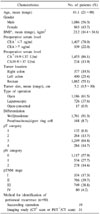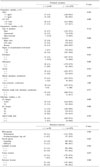Abstract
Purpose
Peritoneal recurrence after curative resection of colorectal cancer has been considered to be a lethal condition and to be suitable for palliative chemotherapy. Recently, aggressive approaches such as cytoreductive surgery and perioperative intraperitoneal chemotherapy were introduced for peritoneal malignancies to improve survival. The aim of this study is to identify the risk factors of peritoneal recurrence after curative resection of colorectal cancer and to determine the indication of early postoperative intraperitoneal chemotherapy (EPIC).
Methods
From January 1997 to December 2007, a total of 2,320 patients' records with curative resection for colorectal cancer were collected through the prospective colorectal cancer registry protocol in Kyungpook National University Hospital, Korea. Of those, a total of 1,929 patients were included for analysis of the relationship between perioperative clinicopathologic variables and peritoneal recurrence.
Results
The study group was composed of 1,086 men and 843 women with a mean age of 61.1. In multivariate analysis, preoperative level of serum CA19-9>37 U/ml (odd ratio [OR] 3.217; 95% confidence interval [95% CI] 1.525~6.788), right colon cancer (OR 2.524; 95% CI 1.158~5.502), pT4 tumor (OR 2.131; 95% CI 1.009~4.502) and positive apical lymph node (OR 3.045; 95% CI 1.023~9.066) were independent risk factors of peritoneal recurrence after curative resection of colorectal cancer.
Conclusion
In colorectal cancer patients with increased preoperative serum levels of CA19-9, right-sided location, serosal exposure or invasion of adjacent organ, and positive apical lymph node, more scrupulous surveillance for peritoneal recurrence was necessary during the postoperative follow-up period. In selective patients with risk factors of peritoneal recurrence, more aggressive strategies for management, such as EPIC, were able to be considered under the acceptable general condition and life-expectancy.
Figures and Tables
References
1. Brodsky JT, Cohen AM. Peritoneal seeding following potentially curative resection of colonic carcinoma: implications for adjuvant therapy. Dis Colon Rectum. 1991. 34:723–727.
2. Koppe MJ, Boerman OC, Oyen WJ, Bleichrodt RP. Peritoneal carcinomatosis of colorectal origin: incidence and current treatment strategies. Ann Surg. 2006. 243:212–222.
3. Chu DZ, Lang NP, Thompson C, Osteen PK, Westbrook KC. Peritoneal carcinomatosis in nongynecologic malignancy. A prospective study of prognostic factors. Cancer. 1989. 63:364–367.
4. Sadeghi B, Arvieux C, Glehen O, Beaujard AC, Rivoire M, Baulieux J, et al. Peritoneal carcinomatosis from non-gynecologic malignancies: results of the EVOCAPE 1 multicentric prospective study. Cancer. 2000. 88:358–363.
5. Glehen O, Kwiatkowski F, Sugarbaker PH, Elias D, Levine EA, De Simone M, et al. Cytoreductive surgery combined with perioperative intraperitoneal chemotherapy for the management of peritoneal carcinomatosis from colorectal cancer: a multi-institutional study. J Clin Oncol. 2004. 22:3284–3292.
6. Yan TD, Black D, Savady R, Sugarbaker PH. Systematic review on the efficacy of cytoreductive surgery combined with perioperative intraperitoneal chemotherapy for peritoneal carcinomatosis from colorectal carcinoma. J Clin Oncol. 2006. 24:4011–4019.
7. Vaillant JC, Nordlinger B, Deuffic S, Arnaud JP, Pelissier E, Favre JP, et al. Adjuvant intraperitoneal 5-fluorouracil in high-risk colon cancer: a multicenter phase III trial. Ann Surg. 2000. 231:449–456.
8. Yu W. A review of adjuvant therapy for resected primary gastric cancer with an update on Taegu's phase III trial with intraperitoneal chemotherapy. Eur J Surg Oncol. 2006. 32:655–660.
9. Japanese Society for Cancer of the Colon and Rectum. Japanese Classification of Colorectal Carcinoma. 1997. Tokyo: Kanehara & Co., Ltd..
10. Hartley JE, Mehigan BJ, MacDonald AW, Lee PW, Monson JR. Patterns of recurrence and survival after laparoscopic and conventional resections for colorectal carcinoma. Ann Surg. 2000. 232:181–186.
11. Obrand DI, Gordon PH. Incidence and patterns of recurrence following curative resection for colorectal carcinoma. Dis Colon Rectum. 1997. 40:15–24.
12. Galandiuk S, Wieand HS, Moertel CG, Cha SS, Fitzgibbons RJ Jr, Pemberton JH, et al. Patterns of recurrence after curative resection of carcinoma of the colon and rectum. Surg Gynecol Obstet. 1992. 174:27–32.
13. Manfredi S, Bouvier AM, Lepage C, Hatem C, Dancourt V, Faivre J. Incidence and patterns of recurrence after resection for cure of colonic cancer in a well defined population. Br J Surg. 2006. 93:1115–1122.
14. Malcolm AW, Perencevich NP, Olson RM, Hanley JA, Chaffey JT, Wilson RE. Analysis of recurrence patterns following curative resection for carcinoma of the colon and rectum. Surg Gynecol Obstet. 1981. 152:131–136.
15. Cass AW, Million RR, Pfaff WW. Patterns of recurrence following surgery alone for adenocarcinoma of the colon and rectum. Cancer. 1976. 37:2861–2865.
16. Jayne DG, Fook S, Loi C, Seow-Choen F. Peritoneal carcinomatosis from colorectal cancer. Br J Surg. 2002. 89:1545–1550.
17. Russell AH, Pelton J, Reheis CE, Wisbeck WM, Tong DY, Dawson LE. Adenocarcinoma of the colon: an autopsy study with implications for new therapeutic strategies. Cancer. 1985. 56:1446–1451.
18. Gilbert JM, Jeffrey I, Evans M, Kark AE. Sites of recurrent tumour after 'curative' colorectal surgery: implications for adjuvant therapy. Br J Surg. 1984. 71:203–205.
19. Sugarbaker PH. Intraperitoneal chemotherapy and cytoreductive surgery for the prevention and treatment of peritoneal carcinomatosis and sarcomatosis. Semin Surg Oncol. 1998. 14:254–261.
20. Speyer JL. The rationale behind intraperitoneal chemotherapy in gastrointestinal malignancies. Semin Oncol. 1985. 12:23–28.
21. de Bree E, Witkamp AJ, Zoetmulder FA. Intraperitoneal chemotherapy for colorectal cancer. J Surg Oncol. 2002. 79:46–61.
22. Jacquet P, Sugarbaker PH. Peritoneal-plasma barrier. Cancer Treat Res. 1996. 82:53–63.
23. Speyer JL, Sugarbaker PH, Collins JM, Dedrick RL, Klecker RW Jr, Myers CE. Portal levels and hepatic clearance of 5-fluorouracil after intraperitoneal administration in humans. Cancer Res. 1981. 41:1916–1922.
24. Spratt JS, Adcock RA, Muskovin M, Sherrill W, McKeown J. Clinical delivery system for intraperitoneal hyperthermic chemotherapy. Cancer Res. 1980. 40:256–260.
25. Sugarbaker PH. Surgical management of peritoneal carcinosis: diagnosis, prevention and treatment. Langenbecks Arch Chir. 1988. 373:189–196.
26. Verwaal VJ, van Ruth S, de Bree E, van Sloothen GW, van Tinteren H, Boot H, et al. Randomized trial of cytoreduction and hyperthermic intraperitoneal chemotherapy versus systemic chemotherapy and palliative surgery in patients with peritoneal carcinomatosis of colorectal cancer. J Clin Oncol. 2003. 21:3737–3743.
27. Graf W, Westlin JE, Pahlman L, Glimelius B. Adjuvant intraperitoneal 5-fluorouracil and intravenous leucovorin after colorectal cancer surgery: a randomized phase II placebo-controlled study. Int J Colorectal Dis. 1994. 9:35–39.
28. Noura S, Ohue M, Seki Y, Yano M, Ishikawa O, Kameyama M. Long-term prognostic value of conventional peritoneal lavage cytology in patients undergoing curative colorectal cancer resection. Dis Colon Rectum. 2009. 52:1312–1320.
29. Yang SH, Lin JK, Lai CR, Chen CC, Li AF, Liang WY, et al. Risk factors for peritoneal dissemination of colorectal cancer. J Surg Oncol. 2004. 87:167–173.




 PDF
PDF ePub
ePub Citation
Citation Print
Print





 XML Download
XML Download